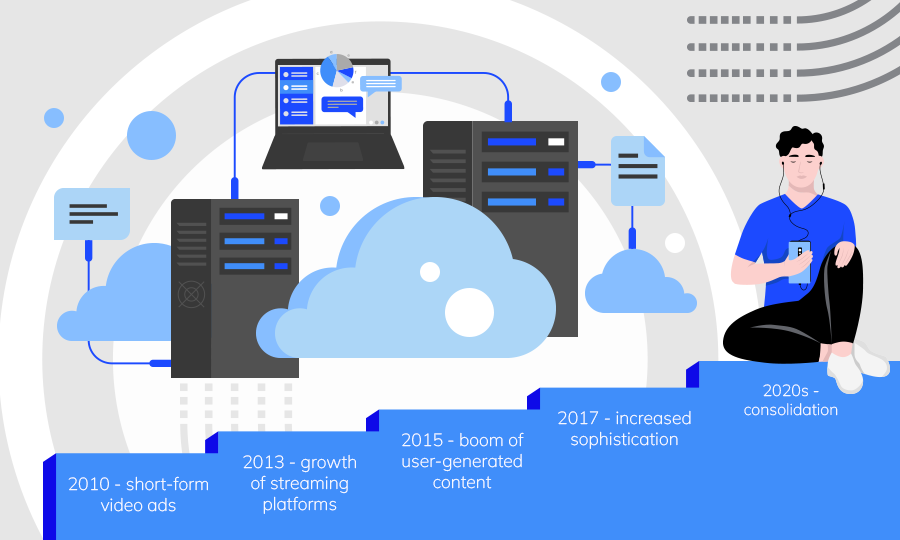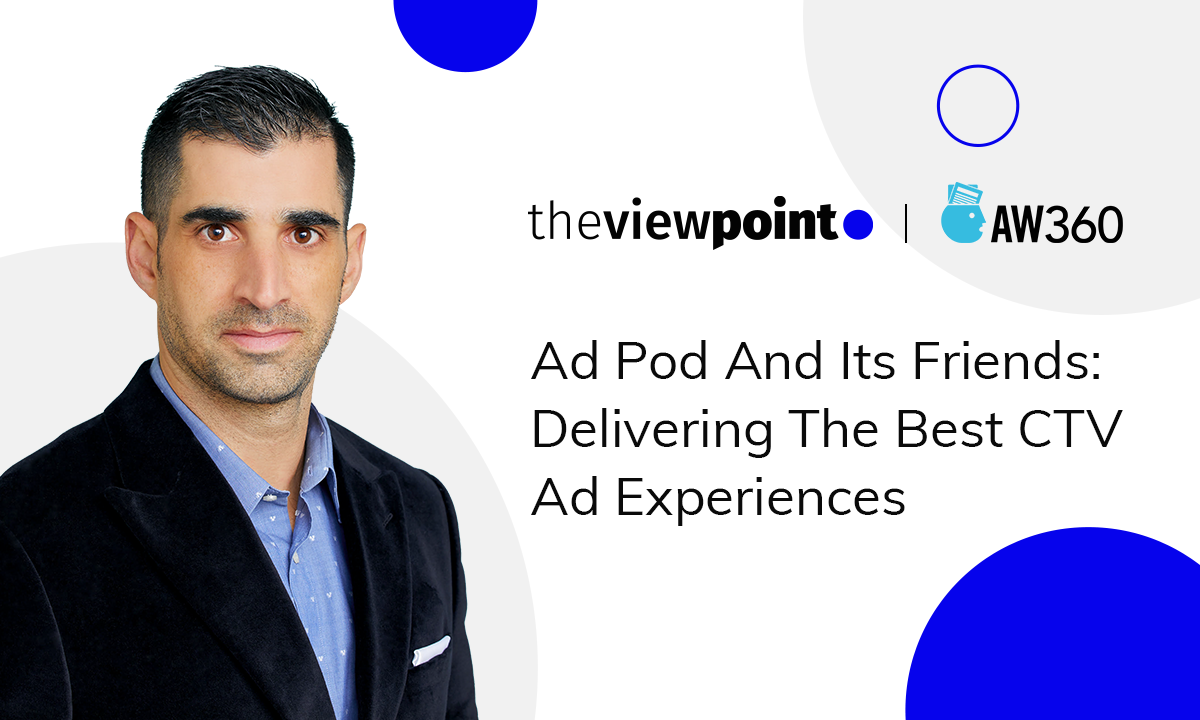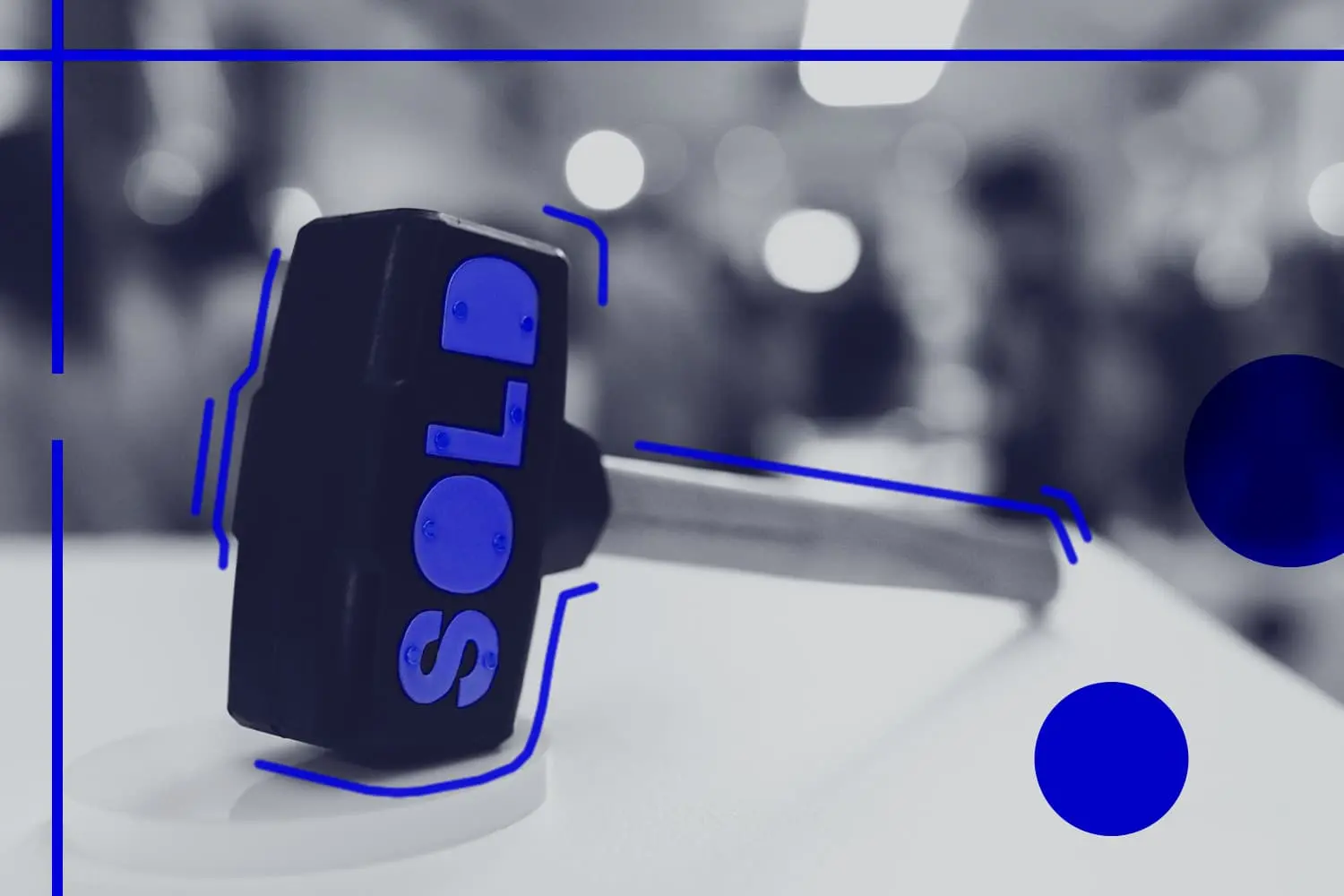
Origins and Pioneers of AdTech: 2010-2022
From the first desktop sidebar ads during the 1990s through the advent of mobile advertising, to the cross-device individual user recognition capabilities of CTV marketing platforms today, the evolution of online advertising has been rapid. When things change so fast, it can be easy to lose sight of how far the industry has come and forget the most crucial aspect of advertising: making sales.
By remembering how things once were, digital advertising professionals can keep perspective and focus on their primary objective: finding the most cost-effective way of putting brands in front of buyers. With that in mind, here is part 2 of our “Origins and Pioneers of AdTech” series, where we discuss the history of online advertising, the key milestones between 2010 and 2022, and how we’ve arrived at “the age of video advertising” that we find ourselves in today.
The condensed history of online advertising
Some of history’s first examples of advertising come from Indian rock art paintings dating back 6000 years. Lost and found advertisements written on papyrus were common in ancient Greece and ancient Rome, and candy sellers in ancient China would play bamboo flutes to let customers know they were open for business. Although rudimentary, these age-old advertising tactics follow the same basic principles that online advertising does today – that of spreading a message to promote a brand or company. Of course, the major difference between then and now is the number of advertisements to which consumers are exposed.
Between clothing and electronic logos, food packaging, billboards, radio ads, mobile ads, ads on websites, and video ads, digital marketing professionals estimate that the average American sees anywhere between 4,000-10,000 ads per day. We’ve learned to filter ads, with perhaps only 100 daily ads getting past this mental screening wall and impacting consumers.
Importantly then, advertisers are constantly struggling to find more effective strategies for standing out and engaging consumers.
The evolution of video ads
Ready access to remote and stable internet coupled with the widespread distribution of smartphones and smart televisions by the late 2000s saw video and online ads become mainstream.
Notably, the release of Apple’s first iPhone in 2007, widely considered the first modern smartphone, meant people could access web content anywhere. This also meant advertisers could get brands in front of consumers on a more personalized level than ever before.
Some consider the release of the iPhone and the consequent smartphone market growth as one of the most significant developments in online advertising. Even now, almost 50% of all video ads are viewed on a mobile device.
Compared to other ad formats, video ads are more engaging, connect better with the audience, and more effectively drive profitable action. So much so that Facebook video ads garner 10-30% more views than other ads, and video posts on Instagram get 38% more engagement than images.
This is why, from 2010 to 2022, we’ve entered “the age of video” because of how much more influential and cost-effective video ads are, compared to other ad formats.
Key milestones between 2010-2022
As discussed in Origins and Pioneers of AdTech: 1990s-2010, it was close to 2010 that real-time bidding (RTB) was introduced. Now, software like Yahoo’s Right Media, Google AdEX, and Microsoft AdECN enabled advertisers to buy individual ad impressions through an auction system. This meant advertisers could now show ads to audiences most likely to take profitable action via the analysis of large datasets.
2010: Short-form video ads
2010 also saw Google launch DoubleClick for Publishers (DFP), giving advertisers control over their ad campaigns, tracking metrics, and performing data analytics from a single location. This was where ad campaign optimization started to take off, as the data collected enabled advertisers and publishers to gain complete insights into the effect their ads were having on viewers, quantify these effects, and make adjustments to optimize.
2010 was an important year for another reason, as it was now that Flash player introduced Video Player-Ad Interface Definition, or VPAID. This facilitated some of the internet’s first ever video ads, often nothing more than simple short-form animation videos.
Different from the images and texts beforehand, these new ads were far more engaging and effective but relied on Flash player. Because there were so many versions of Flash installed on different people’s computers, ads wouldn’t display correctly, which meant advertisers and publishers needed a means of standardizing ad show so they could save online advertising.
2011: Improved video ad rendering
This came in the form of HTML5, which had been on the public market since 2008, but didn’t gain traction until 2010-2011. A universal markup language that could structure and present content on the internet, HTML5 solved VPAID’s problems and gave birth to VPAID 2.
VPAID 2 took the same concepts and ad format as its predecessor, but instead of running on Flash player, the ads were rendered and displayed using JavaScript, a scripting language that enables the dynamic display and control of content and multimedia on websites.
Now no longer dependent on Flash player, advertisers could show web users animated and interactive advertisements without compromising website performance.
2012-2013: The growth of streaming platforms
Around this time, video-on-demand streaming platforms, notably Netflix and Amazon Instant Video, started to grow significantly.
By early 2012, Netflix’s subscriber base had grown to 25.7 million people, nearly 25% on the previous year. Amazon Instant Video also made five thousand movies and TV shows available for Amazon Prime members. By 2013, Netflix had 35.6 million annual subscribers, a 40% increase since 2012.
This was where subscription video-on-demand (SVOD) services really started to take off, suggesting users were willing to pay for ad-free content via subscriptions. This led to Netflix becoming the first streaming service to premiere their own show, producing Lilyhammer in 2012, quickly followed by House of Cards (2013) and Orange Is the New Black (2013).
But this gradual switch from linear TV to connected TV meant people were spending more time watching ad-free long-form video content. What advertisers needed was an opportunity to display their engaging video ads without annoying the viewer to the point of turning them away. Enter YouTube.
2014-2015: The boom in user-generated content
In advertising, it’s well-known that gaining the audience’s trust is essential to moving them along the buyer’s journey. This facet of human psychology allowed advertisers to leverage user-generated content, which viewers automatically trust more than branded adverts.
In 2014, Youtube had over 1 billion annual users visiting the platform, watching content created by channel owners. By cooperating with these content creators, brands could place their products and services in front of audiences in a more genuine, non-intrusive manner. Doing so meant generating content became a potentially lucrative endeavor, which is why 2014 saw the first ‘superstars’ emerge on YouTube.
Personalities such as Zoella, Dan Howell, and PewDiePie were helping YouTube generate over $5 billion in ad revenue in 2014, and using upgraded RTB software from the late 2000s, advertisers started fierce bidding wars as they tried to get their ads in front of this highly-engaged and relevant audience. Advertisers found real value in native ads, where ads are delivered in-stream so as to avoid disrupting the user experience.
Importantly, around 2015, connected TV really started to make in-roads within the U.S market, by which time approximately 40-50% of households had a television connected to the internet. This growth in connected in-house devices, along with mobile smartphone adoption, meant cross-device tracking started to gain traction around 2014-2016.
2016-2017: Increasing sophistication and regulation
2016 was a pivotal year for online advertising, as according to StatCounter, it was the first time in history that internet access via mobile devices exceeded desktop use. This saw a clear change in human behavior at large, both in the amount of time users were spending online and in the way they were interacting with the world wide web.
As consumers started splitting their time between multiple devices, the ability of advertisers to identify a user and then track their online behavior across phones, televisions, and tablets gave rise to an entirely new model for online advertising – one which could put brands in front of consumers at different times, while they were in different moods, and in different locations.
These new variables all meant greater opportunity for online advertisers to generate greater profits from their video ads but also led to the need for more sophisticated services capable of bidding, delivering, tracking, analyzing, and optimizing the ad show process.
2018 – The Present: Google
Up until this point, Google was (and still is) the most dominant search engine. However, the company was yet to impose any significant regulations on the online advertising industry. This changed in 2018 and 2019, with Google introducing several groundbreaking rules to the video advertising industry.
Primarily, these changes included:
Prohibiting auto-play ads on mobile,
Banning video ads that launched with sound,
Banning midroll (short ads) in the middle of short-form video content,
Announced the abolition of third-party cookies.
These recent changes implemented by Google have been at the behest of public sentiment over growing concerns regarding user data privacy and online user experiences and in the desire to improve the online user experience (assumedly to encourage people to continue using the internet longer).
These changes have made advertisers constantly adapt their approach to online marketing, with the end-user increasingly the most important element in the equation. In light of updated industry standards and shifts in user expectations, video-on-demand platforms need to find new, innovative approaches to monetizing their services.
Both launched in 2019, Disney+ and Apple TV have successfully grown their viewerships into the millions by combining SVOD and advertising video-on-demand (AVOD), whereby viewers can opt for free ad-supported subscription tiers. In response to new competition and the growing number of people migrating from linear TV to CTV, Netflix, who has always said there will never be ads on their platform, are also introducing ad-supported subscriptions in Q4 2022.
2019 also saw the launch of new, sophisticated video monetization and advertising platforms such as TheViewPoint. These adtech services enable streaming platforms, such as Disney+ and Apple TV, to deliver a desirable advertising user experience while strategically introducing new monetization strategies.
This ever-growing focus on user experience and delivering an ad experience that contributes to, instead of detracts from, the browsing process has given rise to AdTech companies that can facilitate the type of ad campaign management advertisers require.
Takeaways: The future of advertising
Using the past as a programmatic marketing guide, we see that digital advertising technology has evolved to simplify relationships between advertisers and publishers. All this has been in an attempt to serve ads tailored for segmented audiences and improve the user experience.
With the increasing adoption of virtual reality (VR), blockchain-based metaverse experiences, and IoT devices taking over households, advertisers will need to continue developing and innovating their profession.
With the rise of AI and big data, programmatic advertising will become even more sophisticated. Data science professionals are working to create an experience where ads feel almost personal, with better targeting options for consumers based on their browsing habits.
Related
Programmatic TV Tax Day is Not Just April 15. It's Every Day
This blog examines the significant "AdTech tax" in Connected TV advertising, advocating for Tatari's direct integration with publishers to bypass hidden fees, resulting in substantial cost savings and enhanced transparency.
Read more
Ad Pod And its Friends: Delivering the Best CTV Ad Experiences
Aiming to stand out from the crowd and surpass consumers’ expectations, CTV advertisers have to be allied with publishers and very savvy at applying innovative advertising techniques, like frequency capping, competitive ad separation, and deduplication. Though still raising a lot of eyebrows, these tools have already become the next big thing in the advertising world. So, before diving deep into the details of ad pod management, let’s take a sneak peek behind the scenes of modern CTV play.
Read more
Everything You Need to Know About Real-Time Bidding
As programmatic advertising is gaining momentum, RTB or real-time bidding comes in. In fact, most platforms in ad tech today are RTB enabled. But what does that actually mean? What is an RTB platform and why is it so important for digital marketers? Let’s get the answers to these questions and more.
Read more


